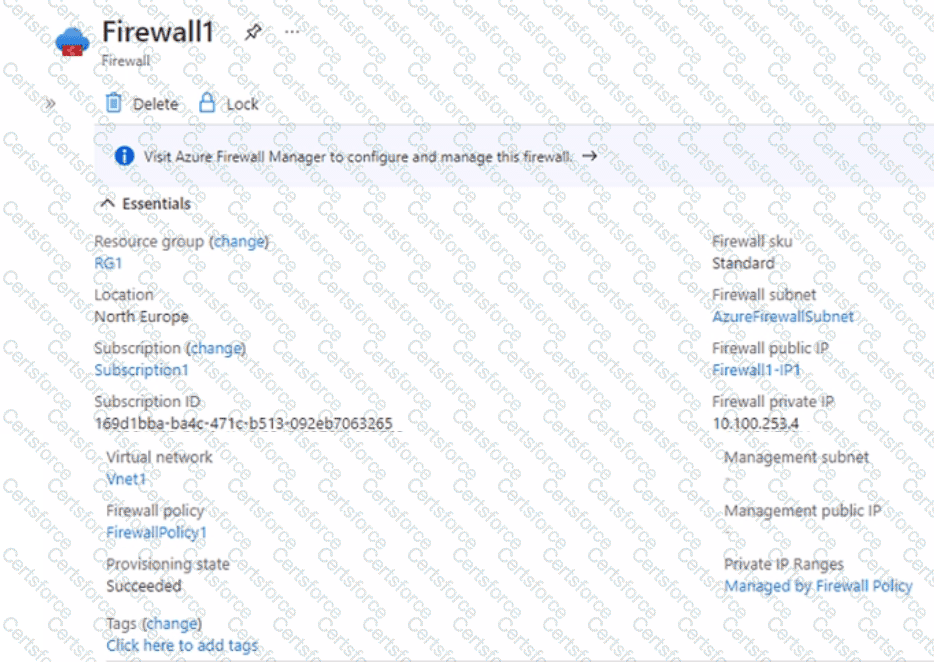Your company has offices in Montreal. Seattle, and Paris. The outbound traffic from each office originates from a specific public IP address.
You create an Azure Front Door instance named FD1 that has Azure Web Application Firewall (WAF) enabled. You configure a WAF policy named Policy! that has a rule named Rule1. Rule1 applies a rate limit of 100 requests for traffic that originates from the office in Montreal.
You need to apply a rate limit of 100 requests for traffic that originates from each office.
What should you do?
Your company has 40 branch offices across North America and Europe. You have an Azure subscription that contains the following virtual networks:
• Two networks in the East US Azure region
• Three networks in the West Europe Azure region
You need to implement Azure Virtual WAN. The solution must meet the following requirements:
• Each branch office in North America must have an ExpressRoute circuit and a Site-to-Site VPN that connects to the East US region.
• Each branch office in Europe must have an ExpressRoute circuit and a Site-to-Site VPN that connects to the West Europe region.
• Transitive connections must be supported between all the branch offices and all the virtual networks.
• Costs must be minimized.
What is the minimum number of Virtual WAN resources required? To answer, select the appropriate options in the answer area. NOTE: Each correct selection is worth one point.

You have the Azure firewall shown in the following exhibit.

Use the drop-down menus to select the answer choice that completes each statement based on the information presented in the graphic.
NOTE: Each correct selection is worth one point.

Task 7
You plan to deploy 100 virtual machines to subnet4-1. The virtual machines will NOT be assigned a public IP address. The virtual machines will call the same API. which is hosted by a third party. The virtual machines will make more than 10,000 calls per minute to the API.
You need to minimize the risk of SNAT port exhaustion. The solution must minimize administrative effort.
Task 11
You are preparing to connect your on-premises network to VNET4 by using a Site-to-Site VPN. The on-premises endpoint of the VPN will be created on a firewall named Firewall 1.
The on-premises network has the following configurations:
• Internal address range: 10.10.0.0/16.
• Firewall 1 internal IP address: 10.10.1.1.
• Firewall1 public IP address: 131.107.50.60.
BGP is NOT used.
You need to create the object that will provide the IP addressing configuration of the on-premises network to the Site-to-Site VPN. You do NOT need to create a virtual network gateway to complete this task.
You have an Azure subscription that contains an Azure Front Door named FD1.
You plan to deploy an app named App1 by using Azure App Service. Users will access App1 by using FD1.
You need to provide FD1 with access to Appl. The solution must meet the following requirements:
• Ensure that users can only access App1 by using FD1.
• Ensure that users cannot access App1 directly from the internet.
What should you create for App1?
You have 50 on-premises networks. Each network contains a server that runs Windows Server.
You have an Azure subscription that contains a virtual network named VNet1. VNet1 contains a database server named DB1.
You plan to deploy an app named App1 that will be hosted on the on-premises servers and will connect to DB1 by using Azure Network Adapter.
What should you use to support the Azure Network Adapter connections to VNet1? To answer, select the appropriate options in the answer area.
NOTE: Each correct selection is worth one point.

Task 9
You plan to use VNET4 for an Azure API Management implementation.
You need to configure a policy that can be used by an Azure application gateway to protect against known web attack vectors. The policy must only allow requests that originate from IP addresses in Canada. You do NOT need to create the application gateway to complete this task.
You have an Azure subscription that contains a virtual network named VNet1. VNet1 has a subnet mask of /24. You plan to implement an Azure application gateway that will have the following configurations:
• Public endpoints: 1
• Private endpoints: 1
• Minimum instances: 1
• Maximum instances: 10
You need to configure the address space for the subnet of the application gateway. The solution must minimize the number of IP addresses allocated to the application gateway subnet.
What is the minimum number of assignable IP addresses required?
You have an Azure subscription that contains a web app named App1 and an Azure Web Application Firewall (WAF) on Azure Front Door instance named FD1. FD1 manages traffic for App1.
You solution high levels of traffic to App1, the traffic is detected and blocked automatically. The solution must minimize administrative effort.
What should you include in the solution?